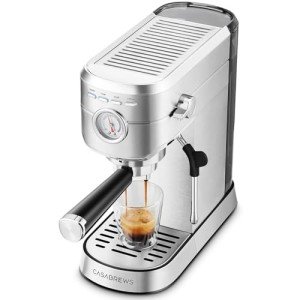Heat Exchange Espresso Machines: A Comprehensive Guide
Espresso machines have developed significantly over the years, accommodating the needs of home baristas and coffee specialists alike. Amongst these machines, heat exchange espresso machines have gotten appeal due to their ability to deliver constant efficiency and remarkable brew quality. In this post, we will check out the workings, advantages, and essential functions of heat exchange espresso machines, providing a comprehensive understanding for both potential purchasers and coffee enthusiasts.
Comprehending Heat Exchange Technology
Heat exchange espresso machines operate on a special concept that permits synchronised water heating for brewing and steaming. They are equipped with a single boiler that uses a heat exchanger system. This function is significant as it enables users to brew espresso while steaming milk simultaneously, promoting performance in the coffee-making procedure.
How Does a Heat Exchange Espresso Machine Work?
The process starts with the machine's water inlet filling the boiler. As the water warms up, it turns to steam. The ingenious heat exchanger uses hot steam to heat extra water in a different passage created specifically for the brew group. This suggests that water can reach the ideal developing temperature level without waiting on the boiler to adjust. The key steps include:
- Water Fill: Water is drawn into the boiler.
- Heating Process: The boiler warms up as water is converted into steam.
- Heat Exchange: Steam heats up water in the heat exchanger tube.
- Brewing: Water from the heat exchanger is pressed through coffee premises, drawing out the flavors needed for an abundant espresso.
This procedure permits for quick temperature level modifications and improved coffee extraction.
Benefits of Heat Exchange Espresso Machines
Heat exchange espresso machines offer several benefits, particularly for those looking to maximize their coffee experience. Here are some crucial advantages:
- Simultaneous Brewing and Steaming: Users can brew espresso while steaming milk, making it perfect for busy cafes and home baristas who value performance.
- Temperature level Stability: The boiler's steam pressure assists keep a steady temperature level, which is vital for constant espresso extraction.
- Versatility: The design enables quick switching between brewing and steaming, making it easier to develop different coffee drinks, from lattes to coffees.
- User-friendly: Models frequently include accessible controls, making it practical for both newbies and skilled baristas to produce quality drinks.
- Professional Quality: Heat exchange machines are typically used in commercial settings, supplying users with high-quality brewing efficiency in the house.
Secret Features to Look for in Heat Exchange Espresso Machines
When considering the purchase of a heat exchange espresso machine, there are a number of features that one need to consider:
- Build Quality: Look for machines made from long lasting materials, such as stainless steel or brass, making sure durability.
- Boiler Size: A bigger boiler will hold more water and sustain higher output over time.
- PID Temperature Control: This function helps preserve constant brew temperatures, which can enhance the coffee-making process.
- Group Head Design: Machines with a saturated or semi-saturated group head offer better temperature stability.
- Reduce of Use: User-friendly interfaces and user-friendly controls boost the general experience for baristas at all ability levels.
- Steam Wand Quality: An excellent steam wand with proper insulation and flexibility permits better texturing of milk.
- Water Reservoir Size: Depending on your requirements, consider how often you desire to refill the water reservoir.
Comparison of Popular Heat Exchange Espresso Machines
To much better comprehend the options available in the market, below is a contrast table of some popular heat exchange espresso machines:
| Machine Model | Boiler Size | PID Control | Cost Range | User Ratings |
|---|---|---|---|---|
| Profitec Pro 700 | 2.0 L | Yes | ₤ 2,000-₤ 2,500 | 9.5/ 10 |
| Rocket Espresso R58 | 1.8 L | Yes | ₤ 2,400-₤ 2,800 | 9.4/ 10 |
| Elekta Bianca | 1.8 L | Yes | ₤ 2,500-₤ 3,000 | 9.6/ 10 |
| La Spaziale S1 Vivaldi II | 1.5 L | Yes | ₤ 1,800-₤ 2,200 | 9.2/ 10 |
| Bezzera Magica | 1.2 L | No | ₤ 1,600-₤ 1,800 | 9.0/ 10 |
FAQs About Heat Exchange Espresso Machines
What is the main distinction in between a heat exchange and a dual boiler espresso machine?
While both types can brew espresso and steam milk at the same time, dual boiler machines have different boilers for developing and steaming. In Suggested Online site , heat exchange machines use a single boiler and a heat exchanger to attain the very same function.
Are heat exchange machines appropriate for newbies?
Yes! Numerous heat exchange machines are developed with user-friendly features, making them accessible for newbies. With appropriate guidance and practice, users can quickly produce quality espresso.
What kind of upkeep do heat exchange espresso machines need?
Routine maintenance includes descaling, cleaning the boiler, examining seals and gaskets, and keeping the group head tidy. Regular maintenance guarantees durability and constant efficiency.
Can I use a heat exchange machine for different kinds of coffee beverages?
Absolutely! Heat exchange machines enable users to develop a variety of coffee beverages, including espresso, lattes, coffees, and more.
Heat exchange espresso machines represent a mix of development and tradition, offering coffee lovers with the tools required for crafting the best cup. Their capability to all at once brew and steam, integrated with accurate temperature level control, makes them an engaging choice for both home baristas and experts. With the ideal knowledge on functions and maintenance, users can unlock a world of beautiful coffee experiences, ensuring that each sip is as delightful as the last.

